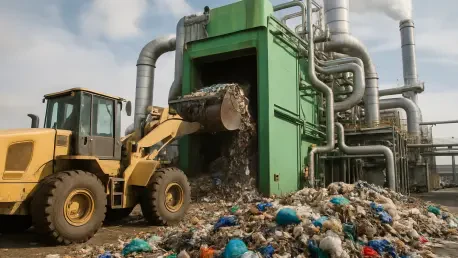The United States grapples with a staggering 292 million tons of municipal solid waste generated annually, a figure that underscores an urgent need for sustainable solutions. Amid this challenge, FCC Environmental Services, the North American branch of the Spanish FCC Group, emerges as a formidable player in the waste-to-energy (WTE) sector. This market analysis delves into FCC’s strategic positioning within the U.S. landscape, examining how its European-rooted expertise and recent operational strides are shaping industry trends. The purpose of this exploration is to provide stakeholders with critical insights into the evolving WTE market, highlighting growth opportunities, regulatory dynamics, and innovative approaches that could redefine waste management in America.
Market Dynamics: FCC’s Entry and Expansion in the U.S. Waste-to-Energy Sector
Leveraging a Global Legacy for Local Impact
FCC Environmental Services brings a wealth of experience from operating 13 WTE facilities across Europe, primarily in the UK, Spain, and Austria, for over two decades. This extensive background in managing emissions and modernizing outdated plants provides a competitive edge as the company navigates the U.S. market. Since establishing a foothold in municipal solid waste collection in Florida, FCC has expanded its operations across seven states, now boasting a fleet of approximately 1,200 vehicles. This robust hauling and recycling network serves as a critical foundation, ensuring a steady supply of waste to fuel its growing WTE ambitions.
Strategic Acquisitions Fueling Market Penetration
A significant milestone in FCC’s U.S. journey came with key operational moves in Florida, a pivotal region for its WTE strategy. The acquisition of the South Broward Waste-to-Energy Facility in Fort Lauderdale, capable of processing 824,000 tons of waste annually, marks a bold step into incinerator ownership. Additionally, a $320.9 million contract to operate Pinellas County’s mass burn combustion facility, handling up to 880,000 tons per year, further solidifies FCC’s presence. These developments not only highlight the company’s ability to scale rapidly but also underscore the importance of integrating hauling operations with energy recovery to maximize efficiency in a fragmented market.
Regulatory Navigation as a Market Differentiator
The regulatory landscape for WTE in the U.S. presents both challenges and opportunities, with the Environmental Protection Agency proposing stricter limits on pollutants like mercury and nitrogen oxides. FCC’s adherence to rigorous European Union emissions standards, updated several years ago, positions it favorably to meet these evolving requirements. The company’s proven track record of upgrading aging infrastructure, exemplified by enhancements to a decades-old plant in the UK, demonstrates its technical prowess. This capability could set a benchmark for compliance, though it demands significant capital investment and close collaboration with local authorities to align with shifting policy timelines.
Emerging Trends and Projections in the U.S. Waste-to-Energy Market
Integration of Holistic Waste Management Solutions
One of the most promising trends in the WTE sector is the move toward integrated facilities that combine incineration with complementary processes like composting and recycling. FCC is at the forefront of this shift with its proposed “EcoPark” in Miami-Dade County, a visionary project aiming to create a comprehensive waste processing hub. Such initiatives reflect a broader industry push toward circular economy principles, where waste is transformed into resources rather than liabilities. If successful, this model could inspire similar developments across other regions, potentially reshaping municipal waste strategies over the coming years.
Technological Advancements Driving Efficiency
Technological innovation remains a critical driver in the WTE market, with advancements in emissions control and energy recovery systems poised to enhance operational sustainability. FCC’s global experience suggests it is well-placed to adopt and adapt these cutting-edge solutions to the U.S. context, potentially reducing environmental footprints while boosting energy output. Market projections indicate that such technologies could see wider adoption by 2027, especially as regulatory pressures mount. The challenge lies in balancing upfront costs with long-term benefits, a hurdle that could determine the pace of industry transformation.
Regional Expansion and Market Flexibility
Beyond current strongholds, FCC’s exploration of new markets signals a dynamic approach to growth. The company is eyeing opportunities in the Northeast U.S. and Canada, demonstrating flexibility by bidding on incinerator contracts even in areas without an established hauling presence. This adaptability aligns with forecasts suggesting a growing demand for WTE solutions in densely populated regions where landfill space is scarce. Industry analysts anticipate that strategic partnerships with municipalities will be crucial for scaling operations, positioning companies like FCC to capture significant market share in untapped territories.
Reflecting on FCC’s Market Impact and Strategic Pathways Forward
Looking back, FCC Environmental Services has carved a notable path in the U.S. waste-to-energy sector through calculated acquisitions and operational contracts in key regions like Florida. Its ability to leverage deep-rooted European expertise offers a distinct advantage in addressing regulatory complexities and infrastructural challenges. The push for integrated solutions, such as the proposed EcoPark, highlights a forward-thinking approach that aligns with circular economy goals. For stakeholders, the next steps involve fostering collaborations with experienced operators like FCC to streamline WTE adoption, while investing in workforce training for emissions control and facility modernization proves essential. Municipalities and businesses alike stand to benefit from prioritizing long-term sustainability over short-term costs, ensuring that waste management evolves into a cornerstone of resource recovery and energy innovation.









